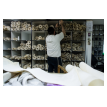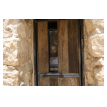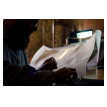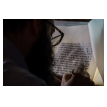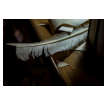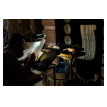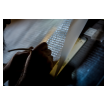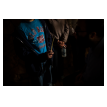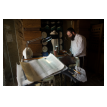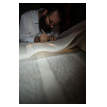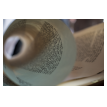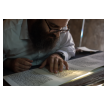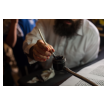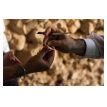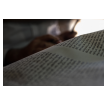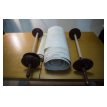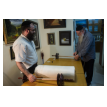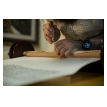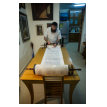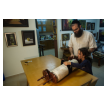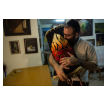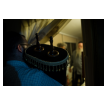The Torah - Jorge Novominsky Photographer
Main menu:
- Home Page
- The Torah
- Bedouin Horse Races
- Modern Breakdance
- Qasr Al Yehud
- Jump Jump
- International Circus Festival
- Oriental Churches Easter in the Holy Land
- Israeli Sport
- Passion ("...Life is an absurd wound...")
- African Hebrew Israelites of Jerusalem
- Silk Road Uzbekistan
- Middle East Conflict
- "tent village"
- Ox Year
- Contact
- Biography
The Torah
The Torah
This is the story of the art of writing a Sefer Torah, a Torah Scroll,from the very beginning to the end.
A Torah Scroll, the holiest book within Judaism, made up of the five books of Moses, must be written by a specially trained pious scribe called a Sofer Setam.
The process takes a whole year because it’s all written by hand, each letter is inscribed and individually formed with a quill and specially prepared ink. The Torah we use today in the synagogues all around the world is written exactly the same way the Torah was written the very first time by Moses more than 3000 years ago.
Rabbi Louis , the Rabbi of the ancient synagogue of Masada in the Desert of Judea, Israel, a traditional Sofer Setam, draws every one of the 304,805 letters in a Torah Scroll in his studio in the ancient synagogue, in the top of rock plateau on the eastern edge of the Judean Desert, overlooking the Dead Sea.
By simple definition, a sofer is a copyist, but in their religious role in Judaism they are much more. The scribers are craftsmen, calligraphers that works in a very traditional way, using a quill, special black ink and they write in a "klaf", a properly prepared parchment or vellum made of the specially prepared skin of a kosher animal - goat, cattle, or deer. The Torah is made of many sheets of parchment that are sewn together to make one very long scroll.
A sofer must know more than 4,000 Judaic laws before he begins writing a Torah Scroll and he has to be very careful, because even a single missing or misshapen letter invalidates the entire Sefer Torah. After the end of the writing, the scriber read every 42 lines of each page and correct the letters with a razor blade.
Rabbi Louis is a very special kind of scriber. Because the fortification of Masada is a very popular tourist attraction, Rabbi Louis workplace is visited every day by tourists all around the world and he explain every visitor about his work.
Rabbi Louis dedicates a letter to each one of the visitors, he gives them his quill, bless them and write a letter in the klaf. Some of the tourist receive also a blessing in a piece of klaf.
Like most of the scribers, the Rabbi learns this art from his father, that learnt it from his father, is a profession that passes from generation to generation.
I’m trying to tell the story of the writing a Torah scroll from the election of the parchment until the Torah is fully finished and “kosher”, without mistakes. Rabbi Louis finishes the scroll with the help of his little girl. The age of the girl is the same age that he was when he start to learn the profession.
A Torah Scroll, the holiest book within Judaism, made up of the five books of Moses, must be written by a specially trained pious scribe called a Sofer Setam.
The process takes a whole year because it’s all written by hand, each letter is inscribed and individually formed with a quill and specially prepared ink. The Torah we use today in the synagogues all around the world is written exactly the same way the Torah was written the very first time by Moses more than 3000 years ago.
Rabbi Louis , the Rabbi of the ancient synagogue of Masada in the Desert of Judea, Israel, a traditional Sofer Setam, draws every one of the 304,805 letters in a Torah Scroll in his studio in the ancient synagogue, in the top of rock plateau on the eastern edge of the Judean Desert, overlooking the Dead Sea.
By simple definition, a sofer is a copyist, but in their religious role in Judaism they are much more. The scribers are craftsmen, calligraphers that works in a very traditional way, using a quill, special black ink and they write in a "klaf", a properly prepared parchment or vellum made of the specially prepared skin of a kosher animal - goat, cattle, or deer. The Torah is made of many sheets of parchment that are sewn together to make one very long scroll.
A sofer must know more than 4,000 Judaic laws before he begins writing a Torah Scroll and he has to be very careful, because even a single missing or misshapen letter invalidates the entire Sefer Torah. After the end of the writing, the scriber read every 42 lines of each page and correct the letters with a razor blade.
Rabbi Louis is a very special kind of scriber. Because the fortification of Masada is a very popular tourist attraction, Rabbi Louis workplace is visited every day by tourists all around the world and he explain every visitor about his work.
Rabbi Louis dedicates a letter to each one of the visitors, he gives them his quill, bless them and write a letter in the klaf. Some of the tourist receive also a blessing in a piece of klaf.
Like most of the scribers, the Rabbi learns this art from his father, that learnt it from his father, is a profession that passes from generation to generation.
I’m trying to tell the story of the writing a Torah scroll from the election of the parchment until the Torah is fully finished and “kosher”, without mistakes. Rabbi Louis finishes the scroll with the help of his little girl. The age of the girl is the same age that he was when he start to learn the profession.
Home Page | The Torah | Bedouin Horse Races | Modern Breakdance | Qasr Al Yehud | Jump Jump | International Circus Festival | Oriental Churches Easter in the Holy Land | Israeli Sport | Passion ("...Life is an absurd wound...") | African Hebrew Israelites of Jerusalem | Silk Road Uzbekistan | Middle East Conflict | "tent village" | Ox Year | Contact | Biography | General Site Map
